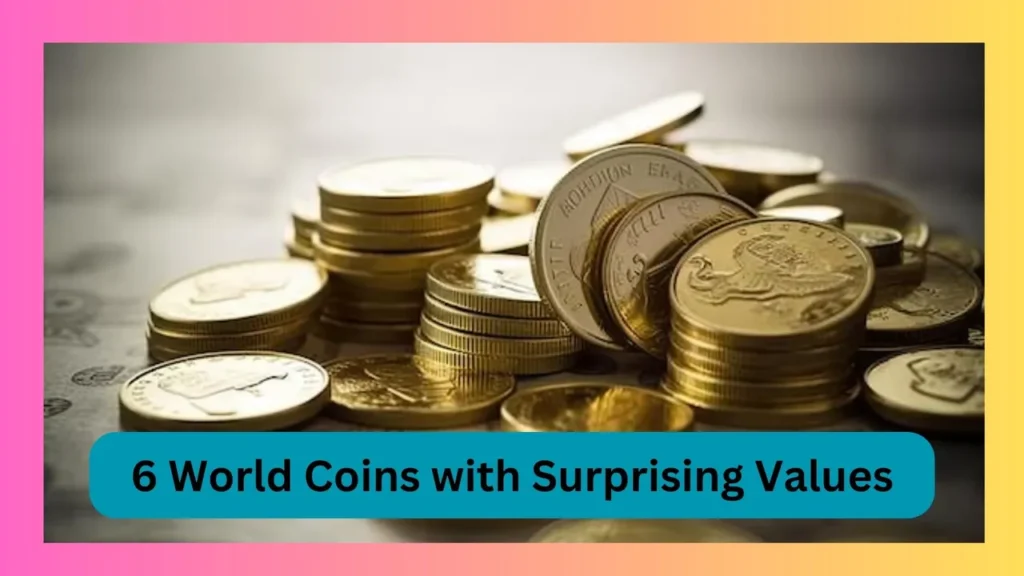Have you ever checked the coins in your pocket and wondered if any of them might be worth a fortune? Most people assume that only rare, ancient coins hold significant value. But here’s the kicker—some everyday coins or old pieces gathering dust in a drawer can be worth thousands, even millions! Whether you’re a collector, an investor, or just someone with a handful of old coins, this list of six world coins with surprising values might just blow your mind. Let’s dive in!

1. 1943 Copper Penny (United States)
Why Is It Valuable?
The U.S. Mint switched to zinc-coated steel pennies in 1943 due to World War II copper shortages. However, a few copper pennies were accidentally struck that year, making them extremely rare.
Value
One of these rare pennies sold for over $1.7 million at auction! If you ever find a 1943 penny that sticks to a magnet, it’s steel. If it doesn’t, you might be holding a fortune!
How to Spot It?
- Check the date: 1943
- Use a magnet: If it doesn’t stick, it’s possibly copper.
- Get it authenticated by an expert.
2. 2007 Queen Elizabeth II “Mule” Dollar (Australia)
Why Is It Valuable?
This Australian $1 coin has a mismatched design mistake—a double rim due to an incorrect die pairing. This minting error makes it incredibly sought after by collectors.
Value
These coins have sold for up to $3,000 at auction.
How to Spot It?
- Look for a thicker double-rim edge.
- Compare it with a regular $1 coin.
3. 1933 Saint-Gaudens Double Eagle (United States)
Why Is It Valuable?
This $20 gold coin was never officially released for circulation due to the U.S. government abandoning the gold standard. However, a few made their way into private hands.
Value
One of these coins sold for a staggering $18.9 million at an auction in 2021, making it one of the most expensive coins ever sold!
How to Spot It?
- Features Lady Liberty on the front and an eagle in flight on the back.
- The date reads 1933.
- Needs professional authentication.
4. 1913 Liberty Head Nickel (United States)
Why Is It Valuable?
The U.S. Mint had stopped producing Liberty Head nickels in 1912, yet a few 1913 versions mysteriously surfaced. Only five are known to exist.
Value
One of these sold for $4.56 million in 2018!
How to Spot It?
- Look for the date 1913 on the front.
- Features Lady Liberty on one side and a “V” (Roman numeral for five) on the other.
- Needs expert verification.
5. 1982 2p “New Pence” Coin (United Kingdom)
Why Is It Valuable?
The UK switched the wording on its 2p coins from “New Pence” to “Two Pence” in 1982. However, a small batch of coins that year was mistakenly minted with “New Pence,” making them rare collector’s items.
Value
Some have sold for over $1,000!
How to Spot It?
- Check for “New Pence” on a 1982-dated coin.
- Compare it with other 2p coins from the same period.
6. 1794 Flowing Hair Silver Dollar (United States)
Why Is It Valuable?
This was the first silver dollar issued by the U.S. Mint, making it a key piece of American history. It is extremely rare, with only about 120 known to exist.
Value
A pristine example was sold for $10 million in 2013!
How to Spot It?
- Features Lady Liberty with flowing hair on the front.
- Has an eagle with a wreath on the back.
- Should be authenticated by a numismatic expert.
What Makes a Coin Valuable?
1. Rarity
The fewer coins available, the higher the demand. Limited mintage or minting errors can increase value significantly.
2. Historical Significance
Coins with historical importance, like those marking the first year of production, often fetch high prices.
3. Condition (Grade)
The better the condition (higher grade), the more valuable the coin. Coins in mint or near-mint condition sell for higher amounts.
4. Errors and Misprints
Coins with rare minting errors, like double strikes or misaligned dies, can be worth a fortune.
5. Precious Metals
Gold, silver, or platinum coins naturally carry value due to the metal content alone.
How to Find Valuable Coins?
- Check Your Spare Change – Valuable coins sometimes slip into circulation.
- Look Through Old Coin Jars – Many rare coins end up in collections without people realizing their worth.
- Attend Coin Shows or Auctions – These events offer a chance to find and buy rare coins.
- Invest in a Coin Guidebook – A numismatic guide can help you identify rare coins easily.
- Get Coins Appraised – If you think you have a valuable coin, consult a professional.
Conclusion
Who knew a simple coin could be worth millions? While most of us toss spare change without a second thought, some of these tiny treasures could be life-changing. From minting errors to historical rarities, the value of coins can surprise even seasoned collectors. So, next time you find an old penny or a foreign coin, take a closer look—you might just strike gold!
FAQs
1. What is the rarest coin in the world?
The 1933 Saint-Gaudens Double Eagle is considered one of the rarest and most valuable coins, with one selling for $18.9 million.
2. How do I know if my coin is valuable?
Check for rare dates, minting errors, or unique features. Getting your coin appraised by an expert is the best way to determine its value.
3. Are old coins always valuable?
Not necessarily. Age alone doesn’t determine value—rarity, demand, condition, and historical significance play bigger roles.
4. Can I still find valuable coins in circulation?
Yes! Some rare coins, like the 2007 Australian mule dollar or error coins, still appear in everyday circulation.
5. Where can I sell rare coins?
You can sell them at auction houses, coin dealers, online marketplaces, or through professional numismatists.